What is Roof Cladding, and How to Choose Cladding Material?

When it comes to roof repairs or replacements in Adelaide and South Australia, homeowners often focus on fixing leaks or upgrading aesthetics. However, roof cladding is more than just a protective layer—it’s an investment in your home, energy efficiency, and long-term value.
With South Australia’s harsh sun, seasonal storms, and coastal winds, the right roof cladding can reduce heat absorption, lower energy bills, and improve weather resistance. Many Adelaide homes still rely on outdated roofing materials that struggle against extreme temperatures, leading to higher cooling costs and faster deterioration. Upgrading to modern metal roof sheeting or insulated cladding not only enhances protection but also adds value to your home while reducing maintenance costs.
Unlike traditional tiles, roof sheeting—especially
Colorbond or Zincalume steel—is lightweight, corrosion-resistant, and built to withstand the Australian climate. Beyond durability, it also plays a crucial role in modern home design, offering a sleek, contemporary look that complements both heritage homes and new builds in Adelaide.
What is Roof Cladding?
Roof cladding is the outermost layer of a roof that provides protection against weather elements such as rain, wind, and sunlight. It acts as a shield, preventing water leaks and structural damage while also enhancing the building's insulation and aesthetic appeal. There are various types of roof cladding materials we work with, including:
- Metal cladding (e.g., steel, aluminium, zinc) – durable and long-lasting.
- Tiles (e.g., clay, concrete, slate) – traditional and visually appealing.
- Polycarbonate or fibreglass sheets – lightweight and translucent for natural lighting.
The choice of roof cladding depends on factors such as climate, budget, durability, and architectural style.
Which is Better: Metal Roof Sheeting or Tiles?
In Adelaide and South Australia, where homes experience hot summers, strong winds, and occasional storms, both tiles and metal sheets offer unique advantages.
Metal roofing is highly durable, lasting 40–50 years, and is resistant to corrosion, wind, and impact damage. It requires minimal maintenance, making it a cost-effective and practical option. However, metal roofs can get hot in summer, so proper insulation is necessary. Installation is faster and more affordable compared to tiles, and modern designs like Colorbond and Zincalume offer sleek aesthetics with a variety of colors.
Tiles have a longer lifespan (50–100 years) and provide natural insulation, keeping homes cooler in summer and warmer in winter. However, they are heavier, require more maintenance due to cracking and moss buildup, and are more vulnerable to wind damage. While more expensive and labour-intensive to install, tiles offer a classic and traditional look that suits heritage homes.
For
Adelaide’s
climate, metal roofing is often the better choice due to its weather resistance, affordability, and low maintenance. However, tiles remain a great long-term investment for homeowners who prioritise aesthetic appeal and insulation. Ultimately, the best choice depends on your budget, home design, and long-term maintenance preferences.
Are Tiles More Prone to Leaks Than Metal Roofs?
Tile roofs can present some challenges when it comes to leaks, particularly compared to metal roofs. However, understanding the factors involved can help homeowners take proactive steps to maintain their roofs. Here are some key points to consider:
- Cracking and Breakage
Over time, clay and concrete tiles may crack or break due to impacts from falling branches, hail, or even foot traffic. Regular inspections can help identify any damaged tiles early, allowing for timely repairs to prevent leaks. - Water Absorption
Some porous concrete tiles can absorb water, which may lead to moisture-related issues if not addressed. Applying sealants or coatings can help minimise water absorption and prolong the life of the tiles. - Shifting and Dislodging
Strong winds and storms can dislodge tiles, potentially creating gaps that allow water to enter. Ensuring that tiles are securely fastened and checking for dislodged tiles after severe weather can mitigate this risk. - Underlayment Maintenance
While tiles are not waterproof on their own, they rely on an underlayment (like a membrane or flashing) to keep leaks at bay. Regularly inspecting and replacing worn underlayment can greatly enhance the roof's water resistance. - Moss and Debris Control
Accumulation of moss, leaves, and other debris between tiles can trap moisture and lead to leaks over time. Regular cleaning and maintenance can help keep the roof clear and improve its durability.
Which Roofing Option Has Fewer Leak Issues?
✅ Metal roofs generally have fewer leak problems if installed correctly, as they form a continuous, sealed surface. However, expansion/contraction and poor installation can cause leaks over time.
✅ Tile roofs are more prone to leaks, mainly due to cracks, displacement, and underlayment wear. Regular inspections and maintenance are essential to prevent leaks.
What are the Most Common Problems with Metal Roof Sheets?
While metal roof sheets are celebrated for their durability and low maintenance, there are steps you can take to address potential issues that may arise from improper installation or maintenance. Here are some constructive insights on common challenges and how to manage them:
- Expansion and Contraction
To mitigate the effects of temperature changes, ensure that fasteners are installed correctly and periodically checked. This will help maintain a secure fit and reduce the risk of leaks. - Noise During Rain or Hail
Consider adding insulation to your metal roof. This can greatly minimise noise during heavy rain or hailstorms, making your home a more peaceful retreat. - Denting and Damage
Opt for high-quality materials such as Colorbond or Zincalume, which are designed to withstand impacts. Additionally, trim nearby branches to prevent any potential damage from falling debris. - Rust and Corrosion
Regularly inspect your roof for scratches and ensure that it’s not installed near corrosive materials. Taking these precautions can help prolong the life of the protective coatings and keep rust at bay. - Improper Installation Leading to Leaks
Engage experienced professionals for installation to ensure that fasteners are sealed properly and seams are securely overlapped. This will help prevent water penetration during storms.
Which Roof Cladding is Best for My Home?
Choosing the best roof cladding depends on several factors, including your climate, budget, maintenance preferences, and aesthetic style. For homeowners in Adelaide and South Australia, where the climate includes hot summers, occasional storms, and coastal conditions, selecting the right material is crucial for durability and energy efficiency.
Contact Done Right Roofing for best and most honest advice and
roof repairs Adelaide.
Emergency Roof Repairs and Roof Inspections Adelaide? We are one call away!
Get in touch with us for all roof repairs, roof replacement and roof plumbing inspections. We serve all Adelaide suburbs.
